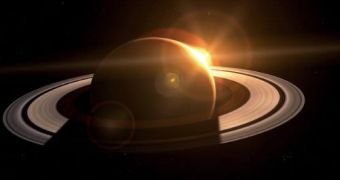The most elusive constant related to the planet that has not been yet accurately determined is its spin rotation, as the gas giant is covered with a thick layer of clouds, which prevents most of the instruments aboard the Cassini probe to make detailed observations. Thus, most of the methods used to measure the spin rotations of gas giants use indirect observations of the magnetic field generated in the core of the planet.
As they passed the planet at the end of the 1970s, Voyager 1 and Voyager 2 spacecrafts also measured the planet's magnetic field and determined that it emits radio waves in the frequencies around the 100 kHz spectrum. By observing the small variations in the frequency of the radio emission scientists can determine the rotation period of a planet covered with thick clouds such as Jupiter, which has a measured spin rotation period of 9 hours and 55 minutes, and has remained relatively stable for the last twenty years.
However, this does not seem to be the case for Saturn, which in the 80s had a rotation period of 10 hours 39 minutes and 24 seconds and fifteen years later presented a decrease in the spin speed, that added an extra six minutes to the time it took to complete a rotation.
Scientists calculated that such a severe drop in its spin speed is impossible for a planet the size of Saturn, thus there must be an interference that is affecting this indirect measuring method. The first explanation for the severe variation in the planet's magnetic field was that it interacts with the solar winds given off by magnetic storms in the Sun's corona or that emissions of particles from its large moon Enceladus during geological activities were also affecting the magnetic field.
Further measurements made with the Cassini-Huygens spacecraft reveal that indeed the variation in the planet's magnetic field is generated by the solar wind as the radio emission from Saturn seems to present a periodical pattern which repeats itself every twenty five days, exactly the time it takes the Sun to complete a spin rotation, from the perspective of Saturn.
This explains only part of the observed phenomena though, as the solar wind variations are only responsible for the short period of time it takes the Sun to complete a rotation. However, the six minute variation seen in fifteen years could be associated with the influence of the particles emitted by Saturn's moon, Enceladus.
For the time being though astrophysicists are working to remove the effects of the solar wind on the planet's magnetic field to finally find its true spin speed rotation, which represents a key component in the study of a planet to reveal the structure of the atmosphere and its interior.

 14 DAY TRIAL //
14 DAY TRIAL //